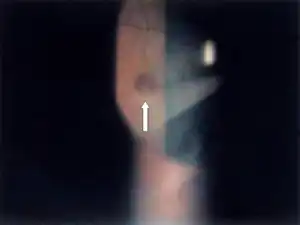Roth spot
| Roth spots | |
|---|---|
| Other names: Litten sign | |
 | |
| Roth spot on the retina of the left eye in infective endocarditis | |
| Specialty | Ophthalmology, cardiology, general medicine |
| Symptoms | Red spots with white or pale centres[1] |
| Causes | Conditions that predispose to endothelial damage of retinal capillaries[1] |
| Diagnostic method | Fundoscopy, visual appearance[1] |
| Frequency | 80% of people with subacute bacterial endocarditis[1] |
Roth spots, also known as Litten spots are non-specific red spots with white or pale centres, seen on the retina.[1] Although traditionally associated with infective endocarditis, they can occur in a number of other conditions including hypertension, diabetes, collagen vascular disease, extreme hypoxia, leukemia and HIV.[2]
The spots are typically observed via fundoscopy (using an ophthalmoscope to view inside the eye) or slit lamp exam.[1][2] They can be composed of coagulated fibrin including platelets, focal ischaemia, inflammatory infiltrate, infectious organisms, or neoplastic cells.[3]
Around 80% of people with subacute bacterial endocarditis have Roth spots.[1] Red and white retinal spots were first observed in 1872 by Swiss physician Moritz Roth, and named "Roth spots" six years later by Moritz Litten.[4]
Cause
Roth's spots occur in conditions that predispose to endothelial damage of retinal capillaries, that is when there is dysfunction and disruption of the endothelium of retinal capillaries.[1] Looking through the microscope reveals lesions with white centers made mainly of fibrin, depicting a fibrin-platelet plug at the site of vessel damage.[1]
Associated conditions
Conditions associated with Roth's spots include:[1][5]
- Infective endocarditis
- Anaemia/thrombocytopenia
- Collagen vascular disease
- Leukemia
- Hypertensive retinopathy
- Diabetic retinopathy
- Pre-eclampsia
- Human Immunodeficiency Virus (HIV)
- Extreme hypoxia
- Shaken-baby syndrome
and also:[2]
- Candida albicans infection
- vascular diseases
- kala azar
Prevalence
Roth's spots occur in only 5% of people with infective endocarditis.[6] Litten, however reported a figure of 80%.[1]
See also
References
- 1 2 3 4 5 6 7 8 9 10 11 Ruddy, Stephanie M.; Bergstrom, Reece; Tivakaran, Vijai S. (18 July 2022). "Roth Spots". StatPearls. StatPearls Publishing. PMID 29494053. Archived from the original on 3 November 2022. Retrieved 3 November 2022.
- 1 2 3 Blumenthal, Eytan Z.; Ehud, Zamir (9 March 1999). "Roth's Spots". Circulation. 99 (9): 1271. doi:10.1161/01.CIR.99.9.1271. PMID 10069798.
- ↑ Lepore, Frederick (1995). "Roth's Spots in Leukemic Retinopathy". New England Journal of Medicine. 332 (5): 335. doi:10.1056/NEJM199502023320515. PMID 7816078.
- ↑ Yale, Steven H.; Tekiner, Halil; Mazza, Joseph J.; Yale, Eileen S.; Yale, Ryan C. (2021). "3. Endocarditis". Cardiovascular Eponymic Signs: Diagnostic Skills Applied During the Physical Examination. Switzerland: Springer. pp. 78–82. ISBN 978-3-030-67595-0. Archived from the original on 2023-07-01. Retrieved 2023-05-28.
- ↑ "What is a roth spot?". Stanford Medicine 25. 24 March 2016. Archived from the original on 3 November 2022. Retrieved 11 August 2019.
- ↑ "What are the classic signs of infective endocarditis (IE)?". www.medscape.com. Archived from the original on 3 November 2022. Retrieved 12 August 2019.